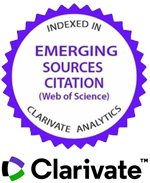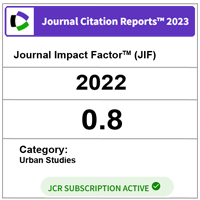3D Topological Validation of Compact Abstract Cell Complexes (CACC) Data Structure for Buildings in CityGML
DOI:
https://doi.org/10.11113/ijbes.v7.n2.457Keywords:
3D Topology, CityGML, Cell ComplexesAbstract
3D models without the preservation of 3D topological information hinders the ability of 3D models to serve its full potential in terms of 3D analyses. The support of 3D topology is crucial for analyses that requires information regarding adjacencies and connectivity. One of the ways to maintain topological information is by implementing a topological data structure such as the Compact Abstract Cell Complexes (CACC) topological data structure. This paper demonstrates the topological validation for the implementation of the CACC topological data structure implemented for buildings in LoD2 CityGML. Directed graphs and adjacency matrices were constructed for the test datasets of buildings in CityGML. The in-degree and out-degree for all vertices were calculated based on the adjacency matrices. Based on the “Hand-shaking” theorem, the number of α₀-cycles of the CACC topological data structure which connects points to form 1D topological links was compared to the number of directed edges of the constructed directed graphs. Therefore, the implementation of the CACC topological data structure for buildings in LoD2 CityGML was found to be topologically sound.References
Aldous, J. M., & Wilson, R. J. (2003). Graphs And Applications: An Introductory Approach , 1. Springer Science & Business Media.
Billen, R., Cutting-Decelle, A.-F., Marina, O., de Almeida, J.-P., Caglioni, M., Falquet, G., Leduc, T., Metral, C., Moreau, G., Perret, J., San Jose, R., Yatskiv, I., & Zlatanova, S. (2014). 3D City Models and Urban Information: Current Issues and Perspectives. Les Ulis cedex A, France: EDP Sciences.
Boguslawski, P., Gold, C. M., & Ledoux, H. (2011). Modelling and Analysing 3D Buildings with a Primal/Dual Data Structure. ISPRS Journal of Photogrammetry and Remote Sensing. 66(2): 188-197.
Clementini, E. (2019). A Conceptual Framework for Modelling Spatial Relations. Information Technology and Control. 48(1): 5-17.
Chen, R. (2011). The Development of 3D City Model and its Applications in Urban Planning. Proceedings of the 2011 19th International Conference on Geoinformatics. 24-26 June. Shanghai, China, 1-5.
Ellul, C. (2007). Functionality and Performance: Two Important Considerations when Implementing Topology in 3D GIS. PhD Thesis, University College London, London.
Ellul, C., & Haklay, M. (2006). Requirements for Topology in 3D GIS. Transactions in GIS. 10(2): 157-175. doi.org/10.1111/j.1467-9671.2006.00251.x.
Ghawana, T., & Zlatanova, S. (2012). Increasing Significance of 3D Topology for Modelling of Urban Structures. Geospatial World Forum 2012. 23-27 April. Amsterdam, The Netherlands.
Gröger, G., & Plümer, L. (2012). CityGML – Interoperable semantic 3D city models. ISPRS Journal of Photogrammetry and Remote Sensing. 71, 12-33. https://doi.org/10.1016/j.isprsjprs.2012.04.004
a.
Hyeyoung, K., Geunhan, K., Chulmin, J., & Hyunjin, Y. (2009). Comparing DBMS-based Approaches for Representing 3D Building Objects. 2009 Joint Urban Remote Sensing Event. 20-22 May 2009. 1-6.
Isikdag, U., Zlatanova, S., & Underwood, J. (2013). A BIM-Oriented Model for Supporting Indoor Navigation Requirements. Computers, Environment and Urban Systems. 41: 112-123. doi: 10.1016/j.compenvurbsys.2013.05.001.
Jahn, M. W., Bradley, P. E., Al Doori, M., & Breunig, M. (2017). Topologically Consistent Models for Efficient Big Geo-Spatio-Temporal Data Distribution. ISPRS Annals of the Photogrammetry, Remote Sensing and Spatial Information Sciences, 4, 65-72. doi:10.5194/isprs-annals-IV-4-W5-65-2017.
Knoth, L., Atazadeh, B., & Rajabifard, A. (2020). Developing A New Framework Based On Solid Models For 3D Cadastres. Land Use Policy. 92: 104480.
Kolbe, T. H. (2009). Representing and Exchanging 3D City Models with CityGML In J. Lee & S. Zlatanova (Eds.), 3D Geo-Information Sciences. 15-31. Berlin, Heidelberg: Springer Berlin Heidelberg. doi: 10.1007/978-3-540-87395-2_2.
Krämer, T., & Huhnt, W. (2009). Topological Information in Geometrical Models of Buildings. ITcon Special Issue: Building Information Modelling Applications, Challanges and Future Directions. 14: 705-723.
Kumar, P. (2014). On the Topological Situations in Geographic Spaces. Annals of GIS. 20(2): 131-137.
Lee, J., & Kwan, M.-P. (2005). A Combinatorial Data Model for Representing Topological Relations Among 3D Geographical Features in Micro-Spatial Environments. International Journal of Geographical Information Science. 19(10): 1039-1056.
Li, L., Luo, F., Zhu, H., Ying, S., & Zhao, Z. (2016). A Two-level Topological Model for 3D Features in CityGML. Computers, Environment and Urban Systems. 59: 11-24.
McDonnell, R., & Kemp, K. (1995). International GIS dictionary. John Wiley & Sons.
Rook, M., Biljecki, F., & Diakité, A. (2016). Towards Automatic Semantic Labelling of 3D City Models. ISPRS Annals of the Photogrammetry, Remote Sensing and Spatial Information Sciences. 4(2W1): 23-30.
Salleh, S., Ujang, U., Azri, S., & Choon, T. L. (2019). Spatial Adjacency Analysis of CityGML Buildings via 3D Topological Data Structure. ISPRS International Archives of Photogrammetry, Remote Sensing and Spatial Information Sciences, XLII-4/W16, 573-579. doi:10.5194/isprs-archives-XLII-4-W16-573-2019
Salleh, S., Ujang, U., Azri, S., & Choon, T. L. (2018). Cell Complexes Topological Links for Buildings in CityGML. ISPRS International Archives of Photogrammetry, Remote Sensing and Spatial Information Sciences, XLII-4/W10, 165-169. doi:10.5194/isprs-archives-XLII-4-W10-165-2018
Salleh, S., & Ujang, U. (2018). Topological information extraction from buildings in CityGML. IOP Conference Series: Earth and Environmental Science. 169(1). doi: 10.1088/1755-1315/169/1/012088.
Ujang, U., Anton Castro, F., & Azri, S. (2019). Abstract Topological Data Structure for 3D Spatial Objects. ISPRS International Journal of Geo-Information. 8(3): 102.
Ujang, U., Abdul Rahman, A., Anton, F. (2014). Three-dimensional Geospatial Compact Abstract Cell Complexes Data Structure for Urban Air Pollution Modelling. PhD Thesis, Universiti Teknologi Malaysia, Malaysia.
Xie, X., Zhu, Q., Du, Z., Xu, W., & Zhang, Y. (2013). A Semantics-constrained Profiling Approach to Complex 3D City Models. Computers, Environment and Urban Systems. 41: 309-317. doi: http://dx.doi.org/10.1016/j.compenvurbsys.2012.07.003.
Downloads
Published
How to Cite
Issue
Section
License
Copyright of articles that appear in International Journal of Built Environment and Sustainability belongs exclusively to Penerbit Universiti Teknologi Malaysia (Penerbit UTM Press). This copyright covers the rights to reproduce the article, including reprints, electronic reproductions or any other reproductions of similar nature.
Authors who publish with this journal agree to the following terms:
- This Journal applies Creative Commons Licenses of CC-BY-NC-SA
- Authors retain copyright and grant the journal right of publication with the work simultaneously licensed under a Creative Commons Attribution License that allows others to share the work with an acknowledgement of the work's authorship and publication in this journal.
- Authors are able to enter into separate, additional contractual arrangements for the non-exclusive distribution of the journal's published version of the work (e.g., post it to an institutional repository or publish it in a book), with an acknowledgement of its publication in this journal.
- Authors are permitted and encouraged to post their work online (e.g., in institutional repositories or on their website) prior to and during the submission process, as it can lead to productive exchanges, as well as earlier and greater citation of published work (See The Effect of Open Access).








